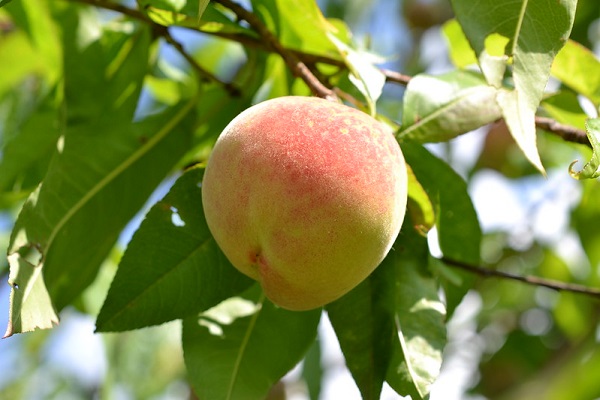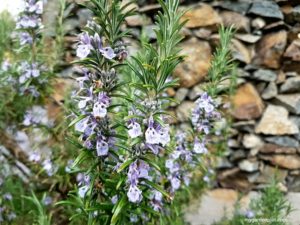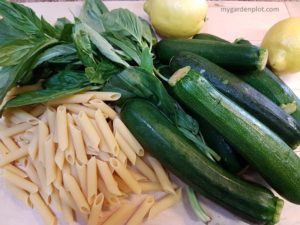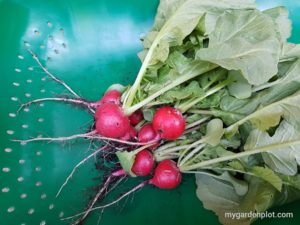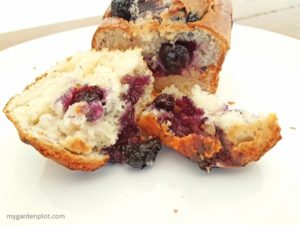About Prunus persica: Peaches And Nectarines
Homegrown peaches and nectarines are super tasty. It is hard to compare store-bought peaches after savouring sweet, juicy fruit from your own tree. Part of what makes homegrown peaches and nectarines delicious is that the fruit can be left to ripen on the tree. One of our first experiences growing a fruit tree was a peach tree. It turns out that these fruit trees require more attention and hands-on than most other fruit trees. Here is a guide on how to grow peach and nectarine trees and how to care and prune for fruit harvest.
As you know, the peach skin is a little fuzzy. Nectarines are just smooth-skinned peaches. Aside from that, both the peach and nectarine fruit trees are similar in growth and care, though nectarines tend to be a little less hardy than peaches. Additionally, most peach and nectarine cultivars are self-fruitful, meaning they self-pollinate to produce fruit – so having more than one tree in the garden is not required. However, a few do need cross-pollination, so check the tree specifications when purchasing at the garden centre. These fruit trees are somewhat short-lived compared to others, but a healthy peach tree can produce fruit for about 20-25 years.
Peach And Nectarines At A Glance
Type: Deciduous Fruit Tree
Location: Full Sun
Seasonal Interest: Spring flowers; Mid Summer to Early Autumn Fruit
When To Prune: Spring or Autumn
Plant Hardiness Zones: 6, 7, 8, 9
When And Where To Plant Peach And Nectarine Trees
The best time to plant peach and nectarine trees is in autumn and before the winter season in areas prone to freezing. In temperate regions, peaches can be planted anytime between late autumn and early spring. Planting in the summer can be stressful to the young tree, and careful attention to watering is needed.
Peach and nectarine trees in the Pacific Northwest need to be planted in a warm, sheltered garden position. Our peach tree is planted south-facing next to the house to protect it from frost and cold winds. A southwest-facing wall or solid fence would also provide the necessary protection and sun exposure needed to successfully grow healthy peach and nectarine trees.
These fruit trees thrive in temperate regions with long, hot summers and prefer a location with plenty of warm sunshine to ripen the fruit. Nectarines need slightly warmer conditions than peaches.
How To Grow And Care For Peach And Nectarine Trees
To grow healthy peach and nectarine trees, they need moist, well-drained soil. They prefer slightly acidic soil with a pH level of about 6.5.
Regular watering is critical for young trees to establish. Once established, peach and nectarine trees benefit from a deep soak but less frequent watering. Nectarines generally need a little more frequent watering than peach trees. Ensure the deep soak covers the entire root zone. Depending on the time of year, soil conditions and how hot the weather is, an established tree will need a deep soak at least once a week.
Mulch or compost applied in late spring helps reduce moisture loss and improve soil conditions and provide essential nutrients. Young trees do not need additional feeding. Once the peach or nectarine tree begins bearing fruit, add a little slow-release balanced organic fruit tree fertilizer in spring. This is important, too, when a lot of wood is pruned from the tree.
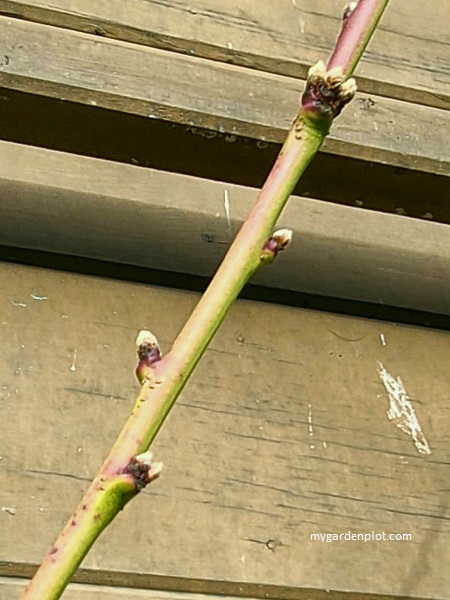
How To Tell The Difference Between Fruit Buds and Leaf Buds
There are two types of buds on peach and nectarine stems, fruit (flower) and vegetative (leaf) bud. These buds can form as single, double, or triple buds. Fruit buds are stouter and fuzzier compared to the leaf bud. As they open up, you can see the petals of the flower. Leaf buds tend to be slim and smoother. Buds at the end of a stem form leafy shoots.
When To Thin Fruit
After flowering and the petals have fallen off, it’s time to consider thinning out the fruit. Once peach or nectarine is about the size of a marble, remove where crowded to reduce fruit clusters. This provides space for healthy growth, and the tree can direct more energy to form a larger fruit. The rule of thumb is one fruit per 15-20 cm (6-8 inches). Revisit during the summer to see whether fruit are still likely to touch and if further thinning is needed.
RELATED TOPIC: Buyer’s Guide On How To Choose Hand Pruners (Secateurs)
Pruning And Training Peach And Nectarine Trees
Fan trained or espalier trees are easier to maintain than a free-standing tree. If planted next to a building or wall, set up a supporting framework for pruning and training. An open centre form (where the central leader is removed) with a short trunk and a vase-shaped array of branches is best for peaches and nectarines – this can take a few years to complete. It is best to keep the tree’s height to no more than 4.5 metres (15 ft). Peach and nectarine trees grow about 30-45 cm (12-18 inches) a year.
While there are impressive examples of professionally fan or espalier-trained trees, your tree at home needn’t be a showstopper. The goal is to keep the tree growing flat against the sheltered wall to create a low, airy tree with a few main ‘scaffolding’ branches from which to grow fruit-bearing stems.
Annual pruning should be done in spring or autumn after all the fruit is harvested. Winter pruning is discouraged as this can increase the risk of disease. In spring, it is best to prune after the last frost, before buds break. In milder regions, it is possible to prune by late winter. Always prune when the weather is forecasted to be dry. In spring, check and remove any winter-damaged branches.
Keep in mind that peaches and nectarines are borne on stems of the previous year’s growth (that is, wood that is one year old). Remove about half of the older wood that has borne fruit. Allowing room for new stems to replace the ones that were removed. Annual pruning increases air ventilation to ward off diseases and keeps it open for sunlight to ripen fruit. Thinning branches is also necessary to keep fruit apart at least 15 cm (6 inches), so no two fruits touch. Remove weaker new stems to allow energy to go to the stronger new growth. Pinch out any unwanted new growth.
Tools Needed For Pruning Peach And Nectarine Trees
Below is the list of essential tools needed to prune a peach or nectarine tree.
- Pruners – Bypass pruners are the most popular choice for gardeners and a must in a pruner’s tool kit. Bypass means the blades pass each other in a scissor-like action providing a clean cut without splintering the stem’s edge. The anvil-type pruner, where the upper blade cuts against a lower flat edge, must always be kept sharp. Otherwise, it will crush the stem while trying to cut it. Pole pruners are also very handy to have especially when pruning trees without a ladder.
- Long-handled Loppers – These are similar to pruners but with long handles. Loppers are heavy-duty and great for harder to reach stems that may also be too thick for pruners. Shop for an extendable loppers for the extra reach.
- Pruning Saw – Saws are useful for thick stems that are growing close together. A Grecian saw or Japanese-blade pruning saw is a handsaw with a curved or straight edge that works with a pull-stroke action. Great for those stems that pruners and loppers can’t cut. It will need a protective case. We also recommend a folding hand saw with a pull-stroke action for smaller gardens. It looks similar to a large pocket knife and works in the same manner as a Grecian saw.
- Garden Gloves – Gardening gloves help keep hands clean and provide protection. Fabric gloves with vinyl offer a good grip on the fingers and palm. Good for warmer weather. For more challenging jobs, a pair of suede or leather gloves go a long way. Not too comfortable in warmer weather, though.
- Support Ties – You will also need some strong and flexible support ties if you are training your preach tree stems and branches.
RELATED TOPIC: Buyer’s Guide On How To Choose A Pruning Saw
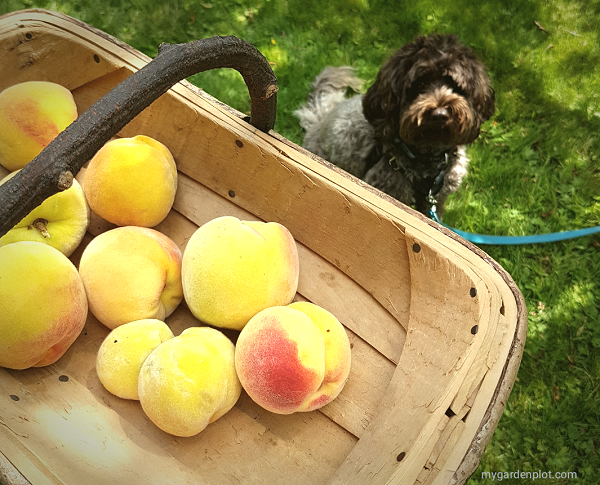
When And How To Harvest Peaches And Nectarines
Homegrown peaches and nectarines can be left on the tree to ripen and harvested in late summer and early autumn. Fruit can be harvested a little earlier and stored in a cool place for a week, but it tastes best picked fresh from the tree. Peaches and nectarines are ripe when slightly soft to the touch at the stalk end of the fruit. It should be able to gently twist and easily detach from the stalk.
Pests And Diseases That Affect Peach And Nectarine Trees
Unfortunately, peach and nectarine trees are susceptible to a variety of pests and diseases. Whenever possible, it always best to invest in resistant cultivars such as ‘Frost’, ‘Pacific Gold’, ‘Redhaven’ and ‘Renton’ peaches.
Several pest and disease problems can be managed while the tree is dormant in winter and following an annual pest-control plan. Common pests include aphids, scale insects, red spider mites, wasps and of course, birds. Familiar fungal diseases such as peach leaf curl, silver leaf, brown rot and bacterial canker can also affect peach and nectarine trees. To manage some of the pest issues and most fungal problems, apply a combination of dormant oil and lime sulphur spray in late winter before leaf growth begins. Attract predators such as ladybugs to eat mites and aphids or use insecticidal soap as an effective method to control these pests.

